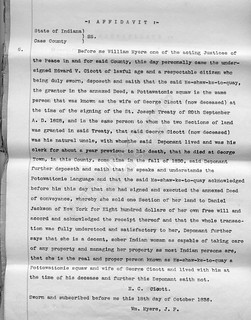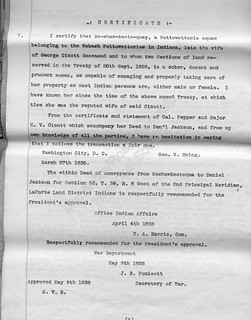
(Click on image to enlarge)
Fredericke and Frederick Suhr. Images from findagrave.com.
Returning to the Harms 73rd Avenue farm, we left off in 1873 when Mary Chester bought the lower forty of the 80-acre parcel.
In September 1874, Mary lost her husband, Charles. In November, she sold her 40 acres to a German immigrant family by the name of Suhr, lending them $921 of the $1,000 purchase price.

(Click on image to enlarge)
Image courtesy of the Eldon Harms family.
I did not recognize that name at first, but I should have: from the early days of this blog, when I was researching the Chester Cemetery, as that is the final resting place of the couple who bought these 40 acres. Back then, I was able to find very little information on them: just the 1880 Census showing Frederick and Fredericke, along with their 27-year-old son, Henry, farming somewhere in Ross Township.
Since 2009, I have discovered findagrave.com, which, through the collective effort of many people, has become a remarkable resource. From information there, I can now fill in some of the missing background, as well as post photos of the Suhrs (above) from the same source.
Frederick and Fredericke (Lichtwarle) Suhr had been married in Germany, their native land, where Frederick worked as a miller. (It was Fredericke's second marriage; her first had produced one son, Charles Schmidt, named for his father.[1]) They came to the U.S. in 1870, evidently just missing the census, and brought with them their three children: Fredrika, Henry, and Emma.[2] They lived in South Chicago at first, but, as we see from our documents above, by 1874 the family moved to Indiana.
Their children all married — most importantly, Emma, in 1887, to Conrad Bender, a man prominent enough in Porter County to rate a biographical sketch in a regional history book, whence I have gleaned some of this information.[3] The other children, Fredrika and Henry, appear to have spent much of their married lives in Illinois.
The Suhrs evidently did well enough on their farm to pay off their mortgage by 1880.
In 1882, at only 65 years of age, Fredericke Suhr died. She was buried in the Chester Cemetery, west of their farm. Frederick then sold the farm and left Indiana to spend the next 15 years in Illinois, probably with one or both of his married children there. He died in 1897, and they brought his body back to Ainsworth, to rest beside Fredericke.
Through their daughter, Emma Bender, their descendants were spread around northwest Indiana. Emma, who died in 1918, was survived by seven children: "Edward F. Bender, of Gary; Mrs. Martha Lute, of Hobart; Mrs. Ida Schenelter of Crown Point; Mrs. Bertha Malone, who lived with her mother in Hobart; Albert C. Bender and Frank J. Bender, who live on and operate the Bender farm in Portage township and Walter F. Bender, of Chesterton."[4]
The real estate transaction we're looking at brought up two other names I recognize from past posts. The mortgage of the land in October 1874 was acknowledged before Justice of the Peace Horace Marble, whose 140-acre parcel just south of Ainsworth included the cemetery. (He was listed there, as a farmer, in the 1870 Census, but by 1880 had moved to Hobart and become a "commission merchant.")

(Click on image to enlarge)
The Horace Marble farm as it appeared on the 1874 Plat Map. Hickory Top had not yet been renamed "Ainsworth."
The assignment of the mortgage, in December 1874, by Mary Chester to her son, Henry, involved J.P. Jesse B. Albee.
_______________
[1] Pictorial and Biographical Record of La Porte, Porter, Lake and Starke Counties, Indiana. Chicago: Goodspeed Brothers, 1894.
[2] "Long Illness Proves Fatal to Mrs. E. Bender," Vidette-Messenger (Valparaiso), Oct. 20, 1933 (transcribed at findagrave.com).
[3] Goodspeed (1894).
[4] "Long Illness Proves Fatal," 1933.













